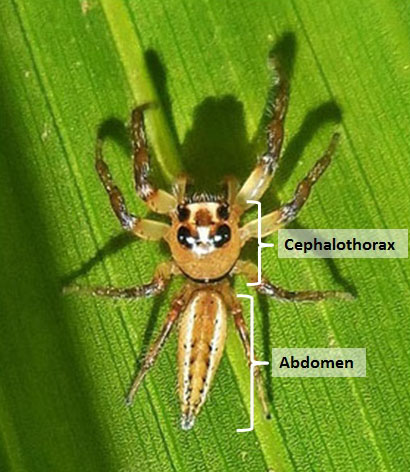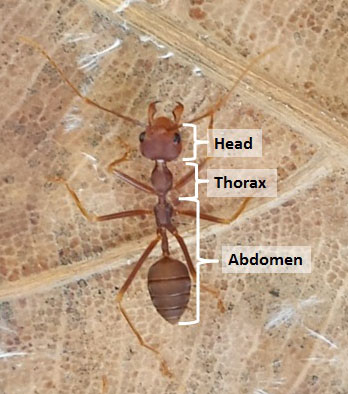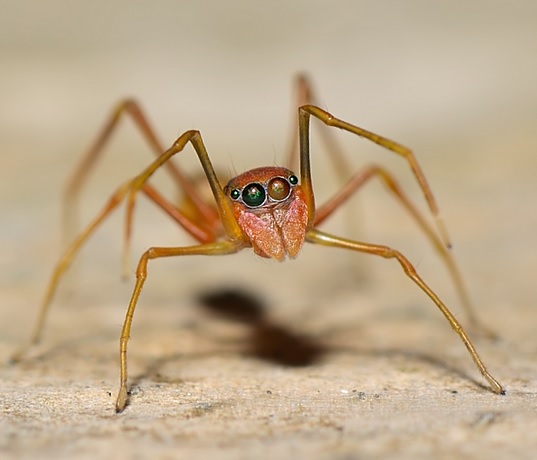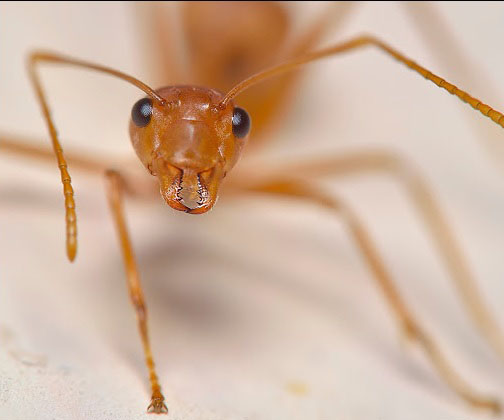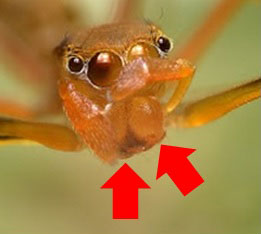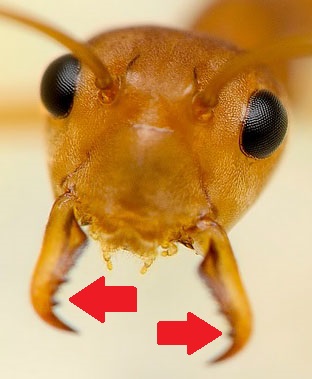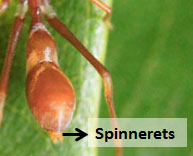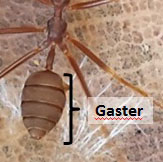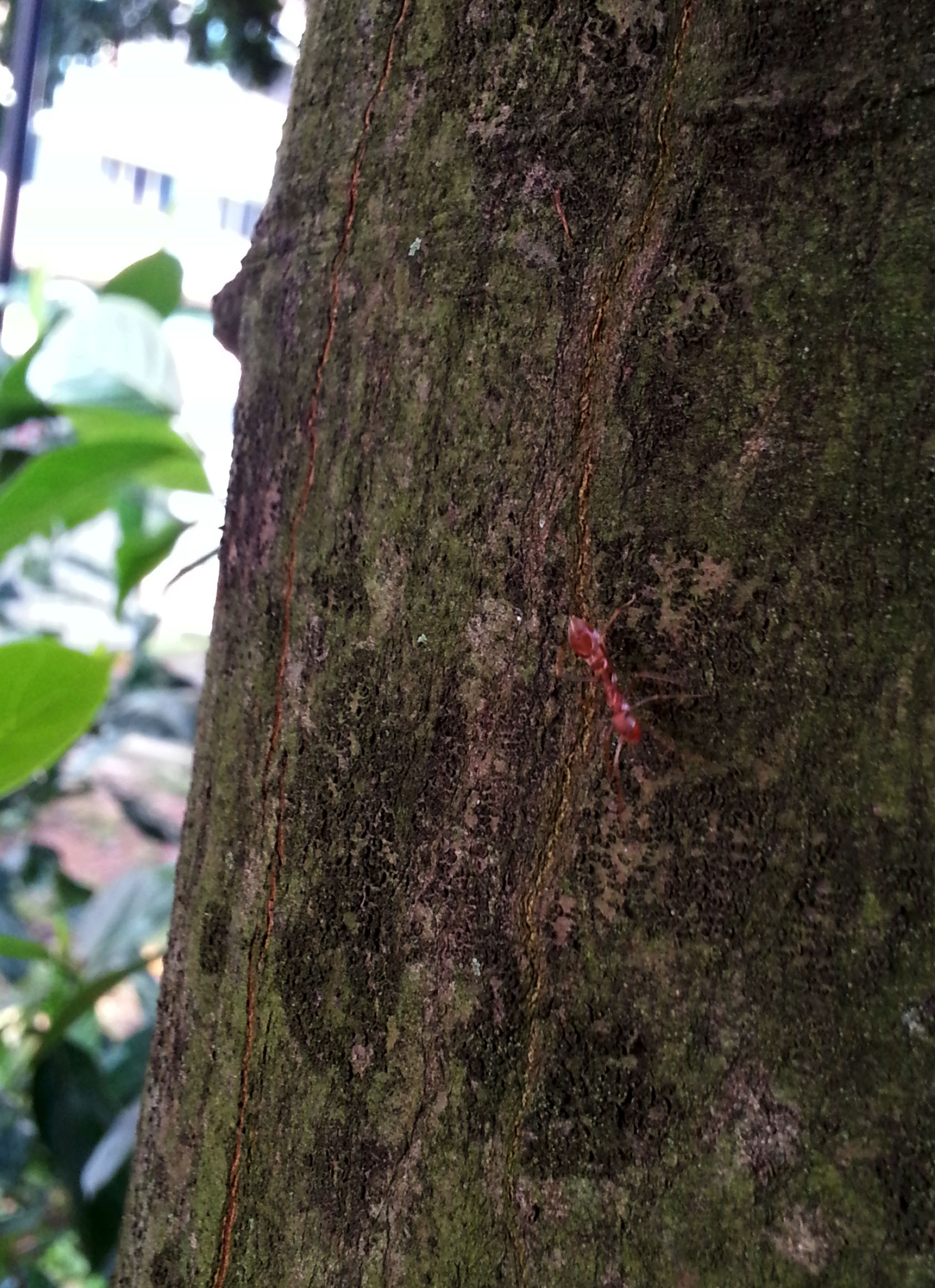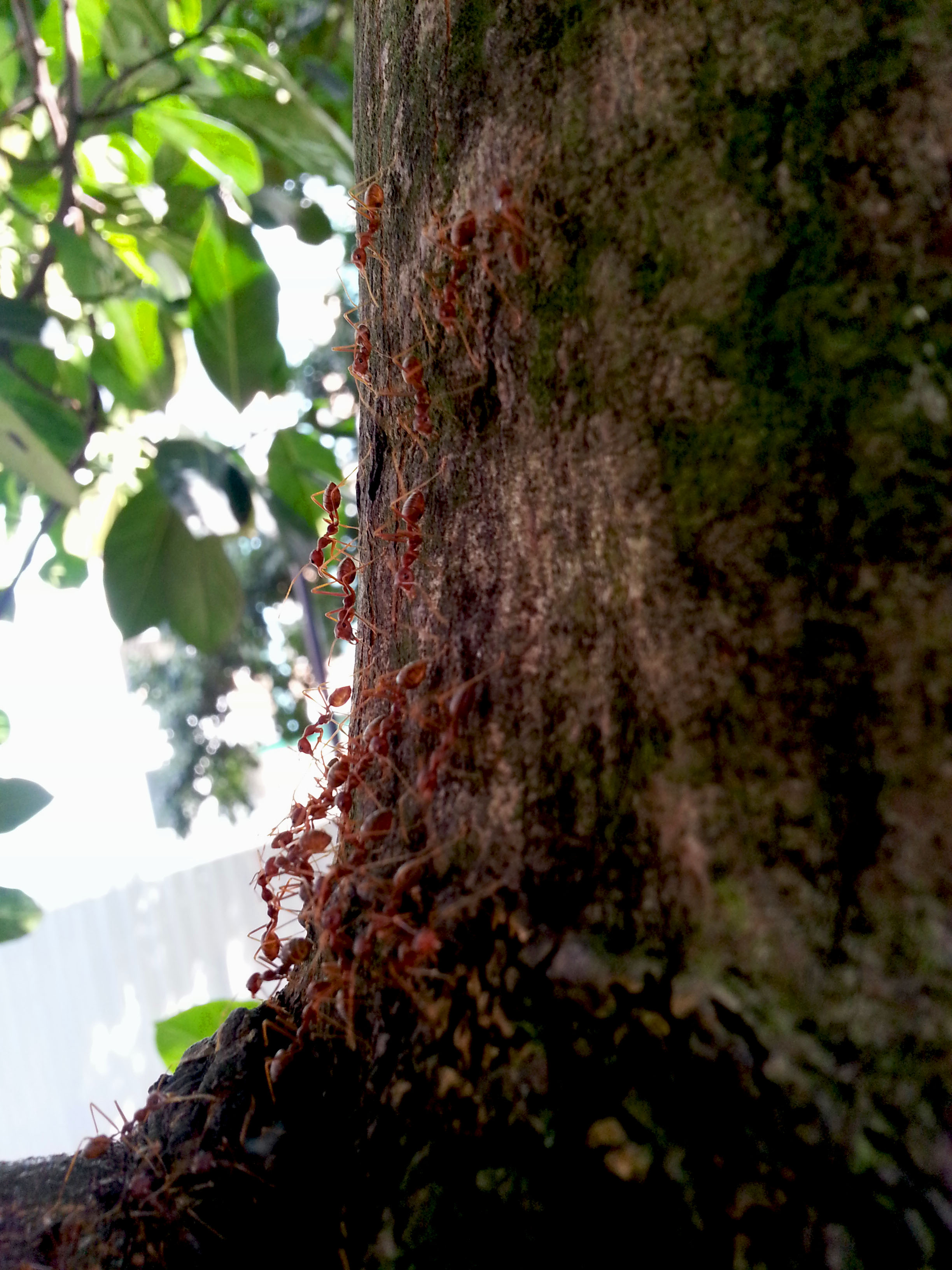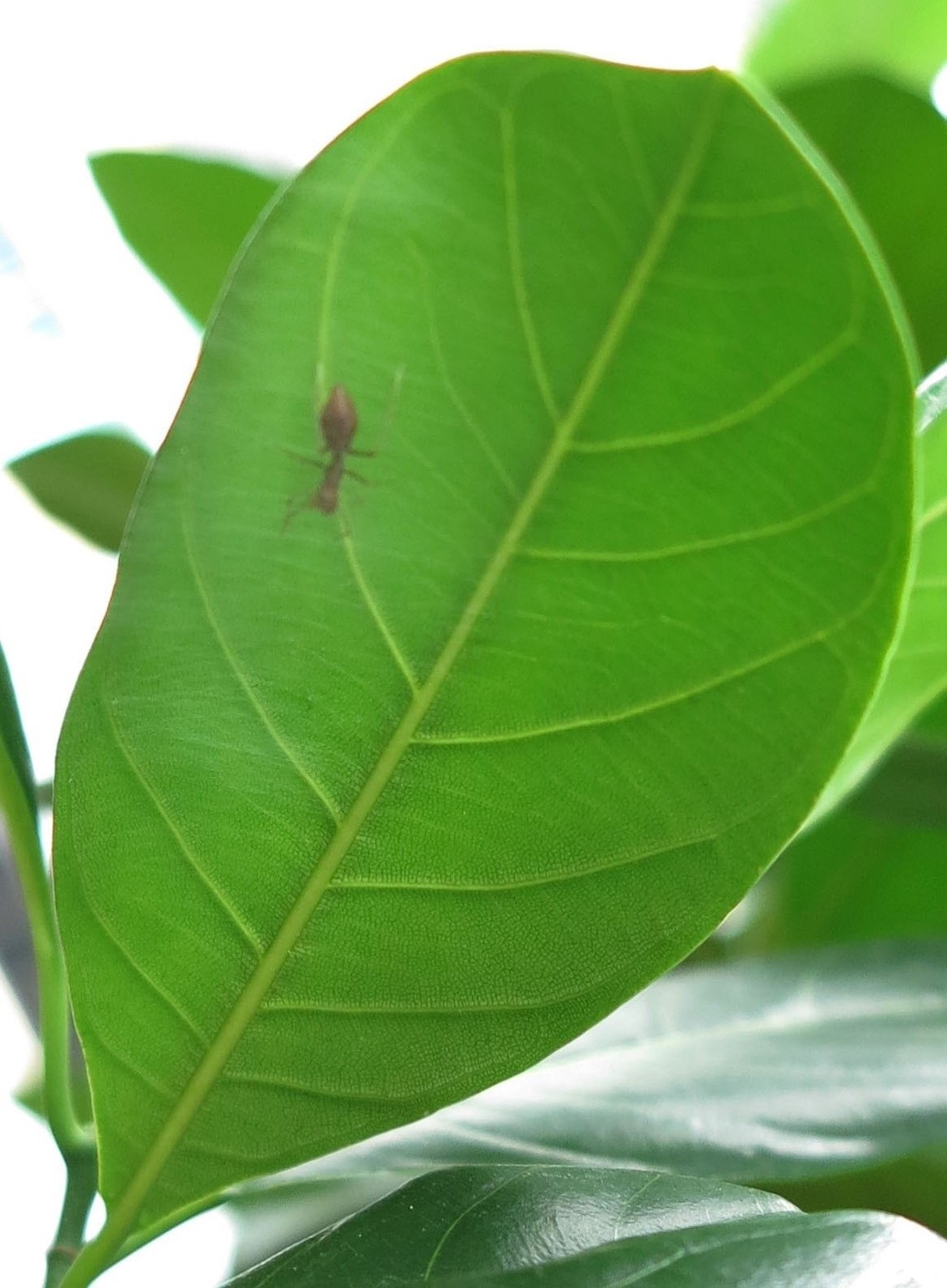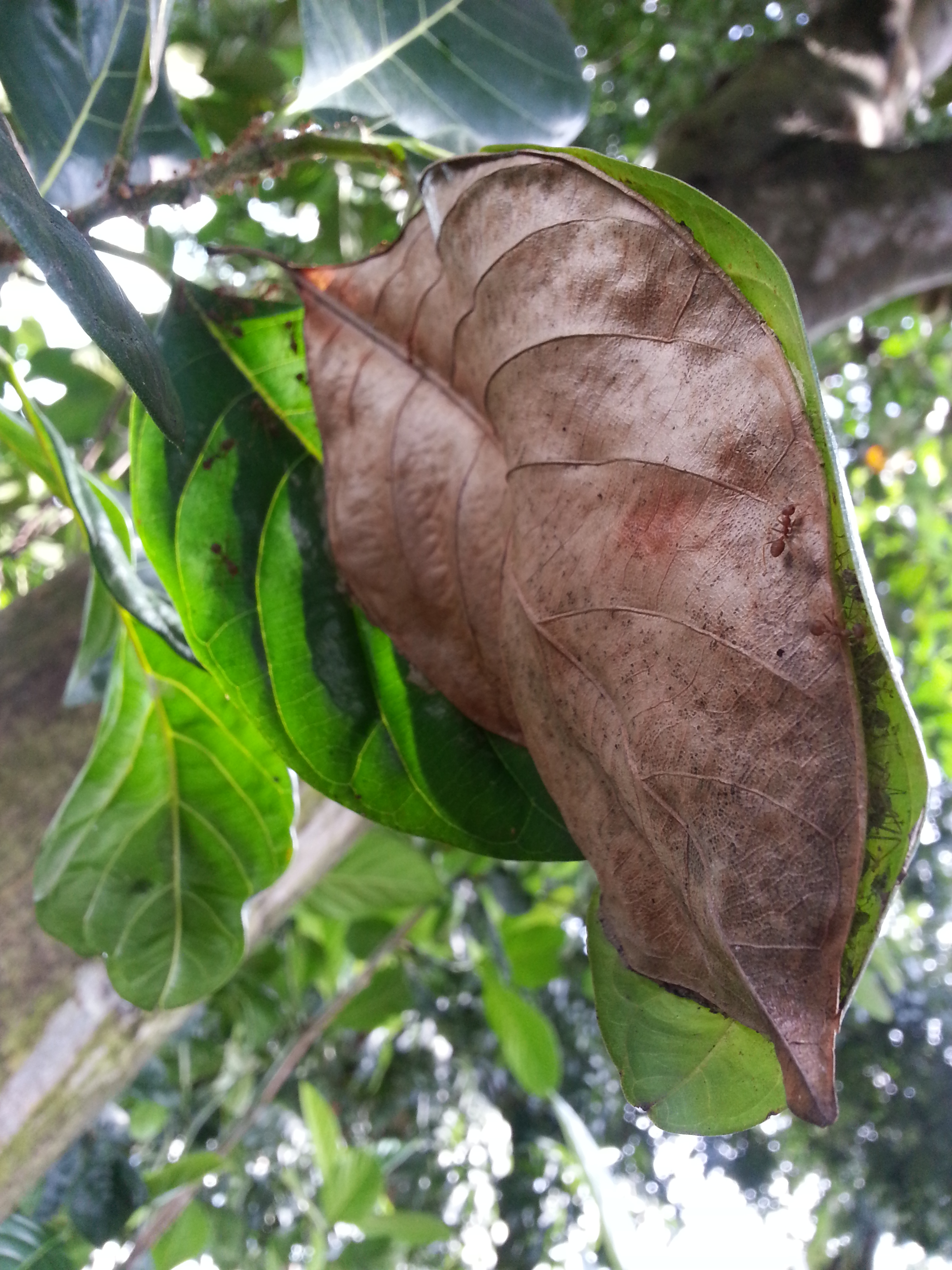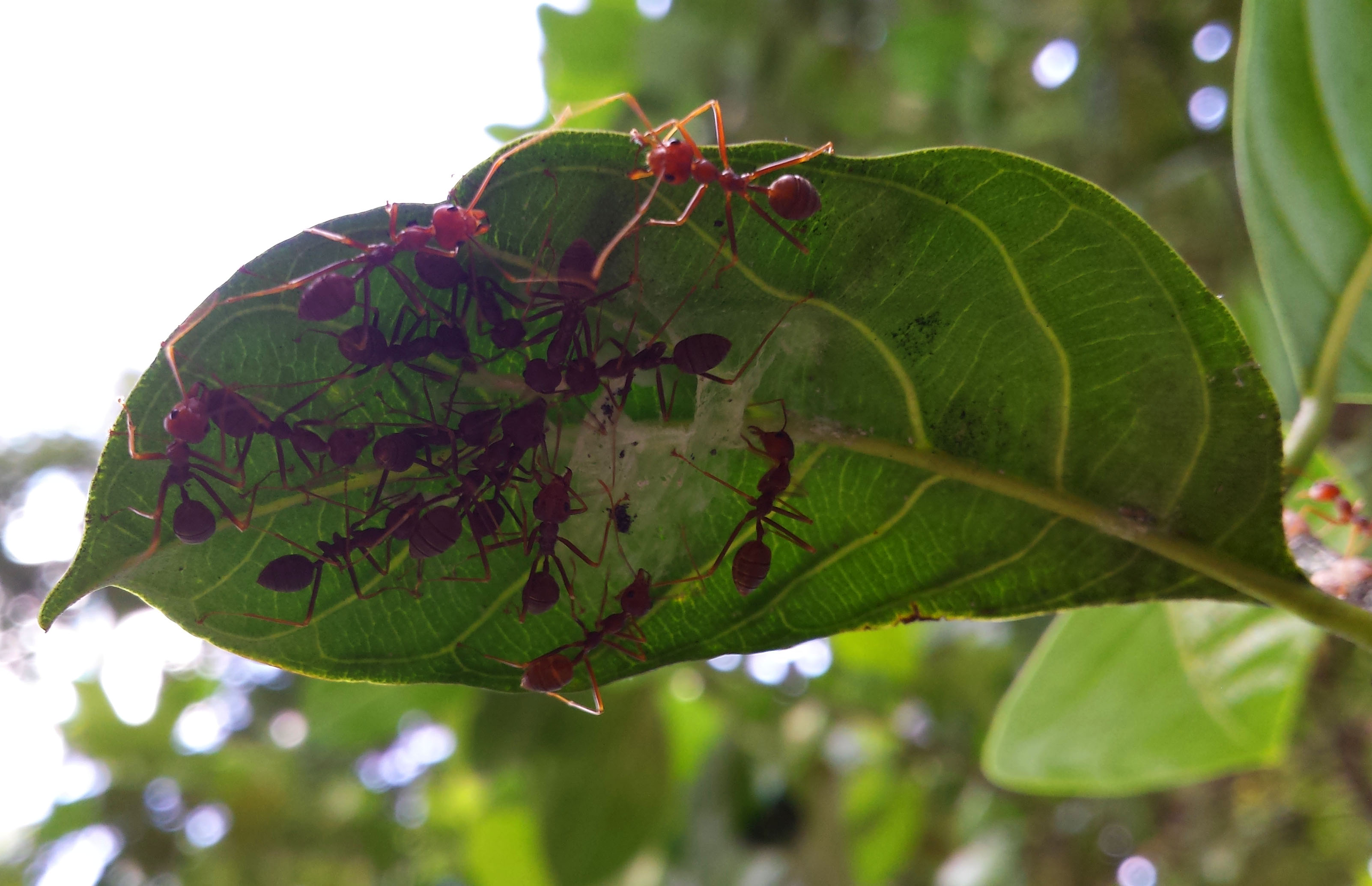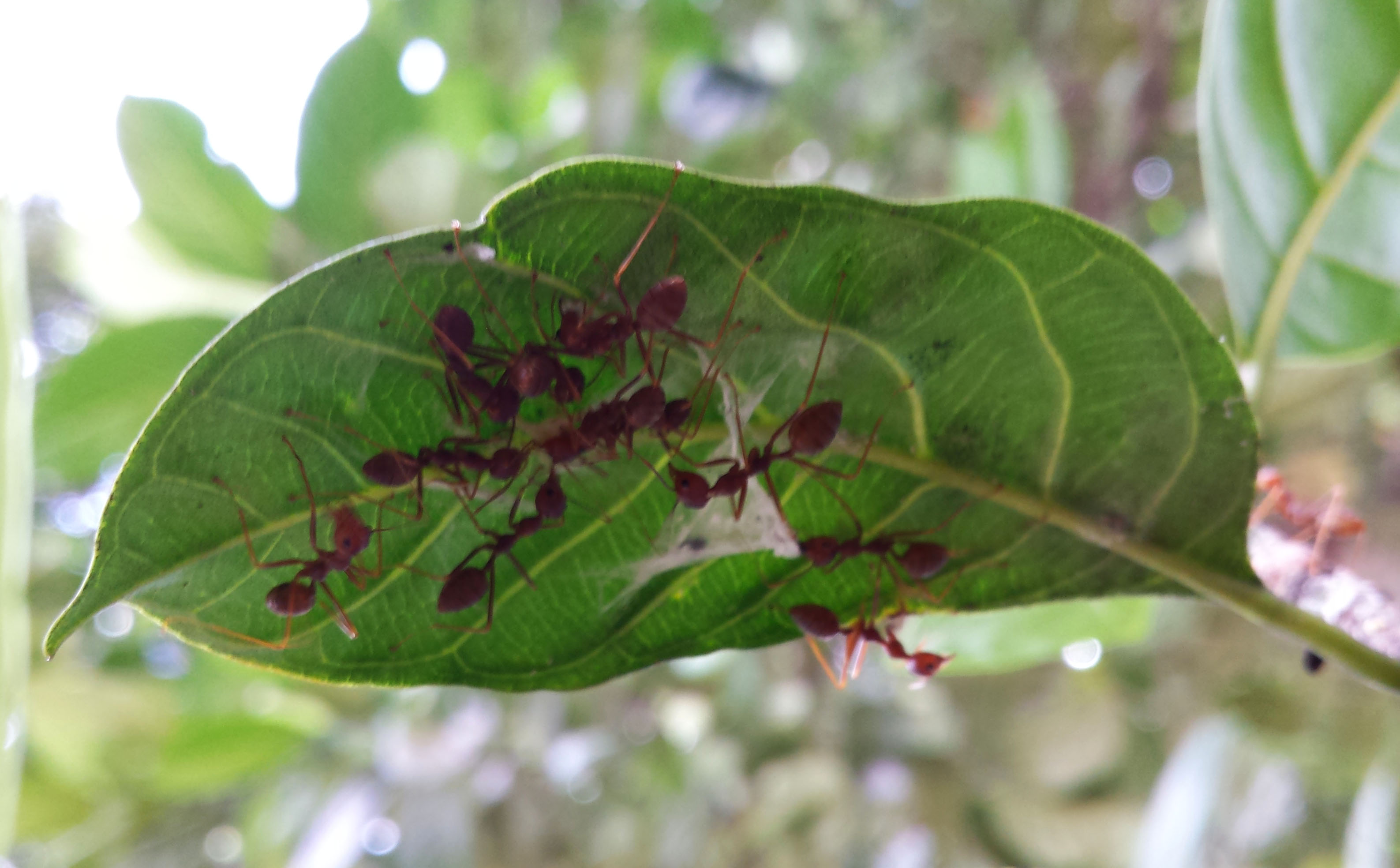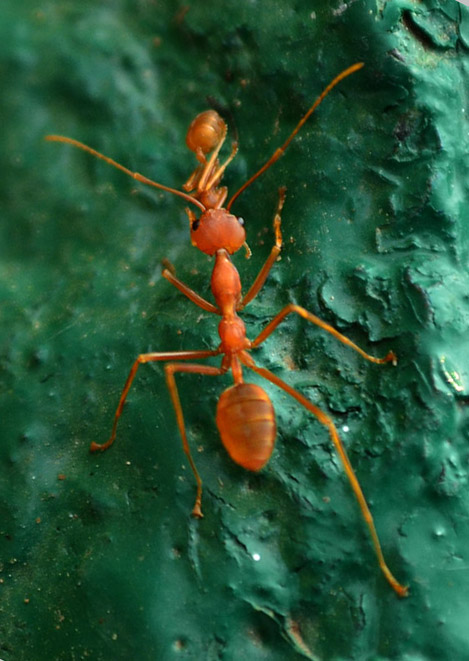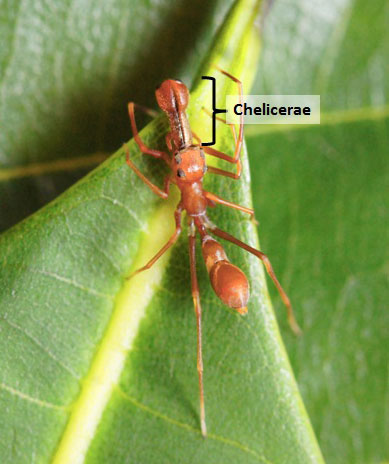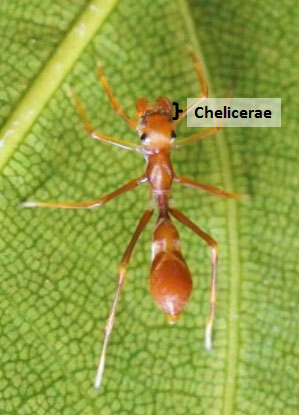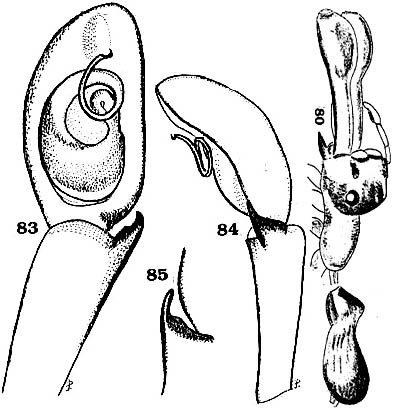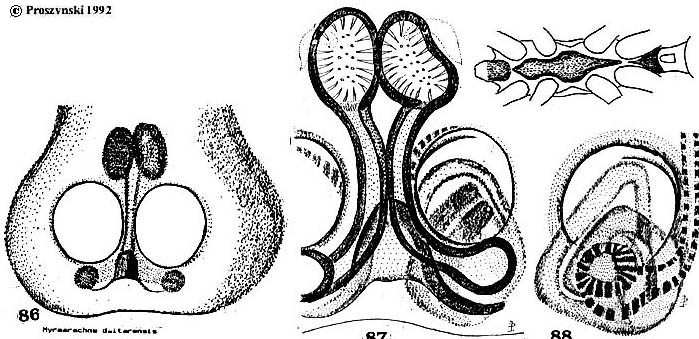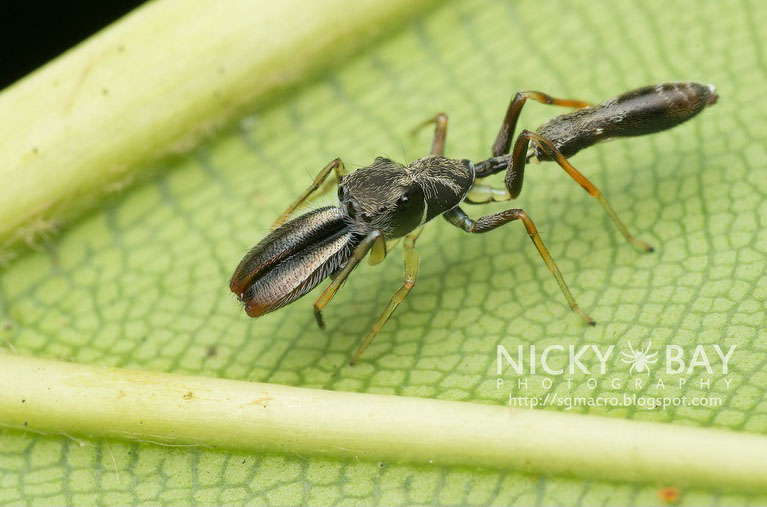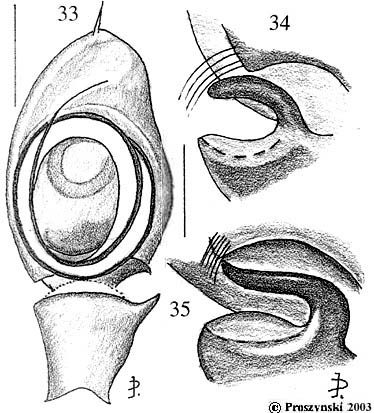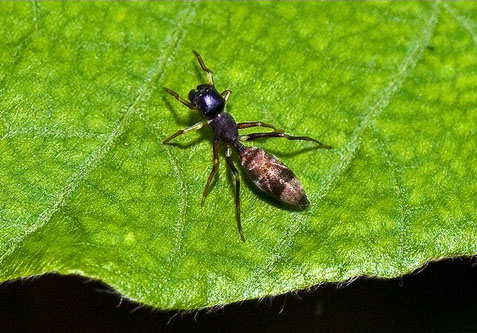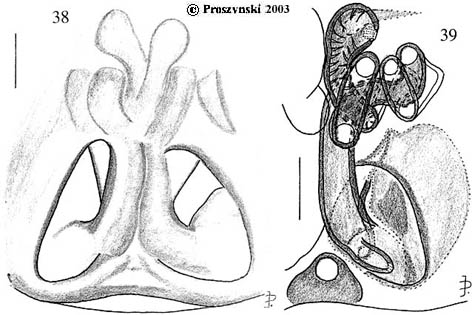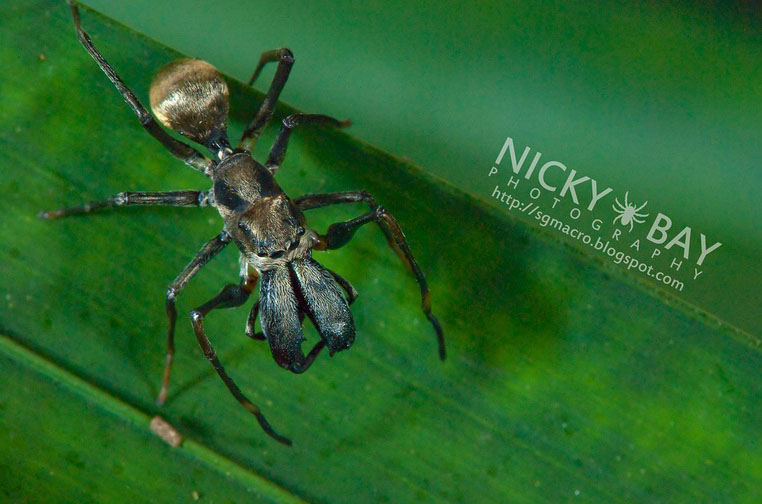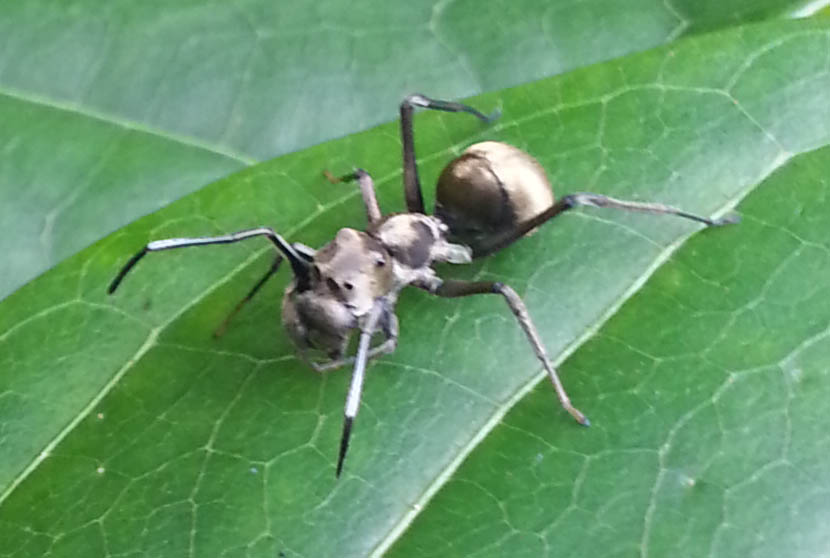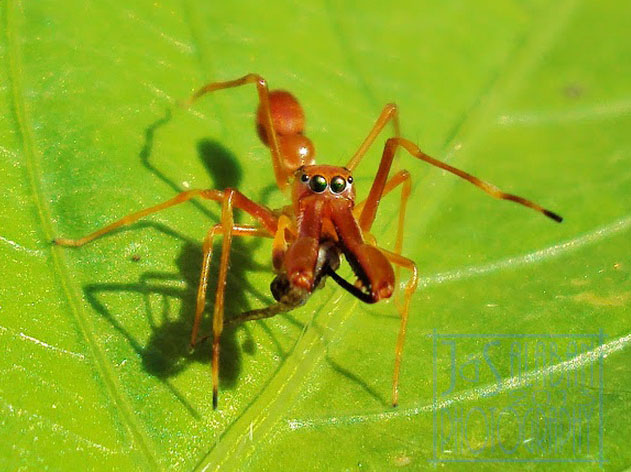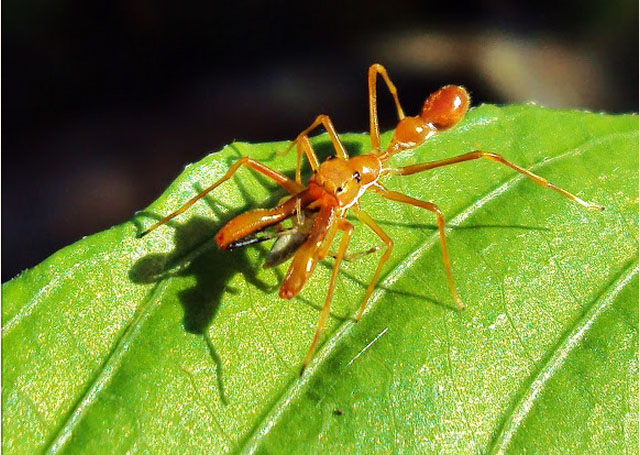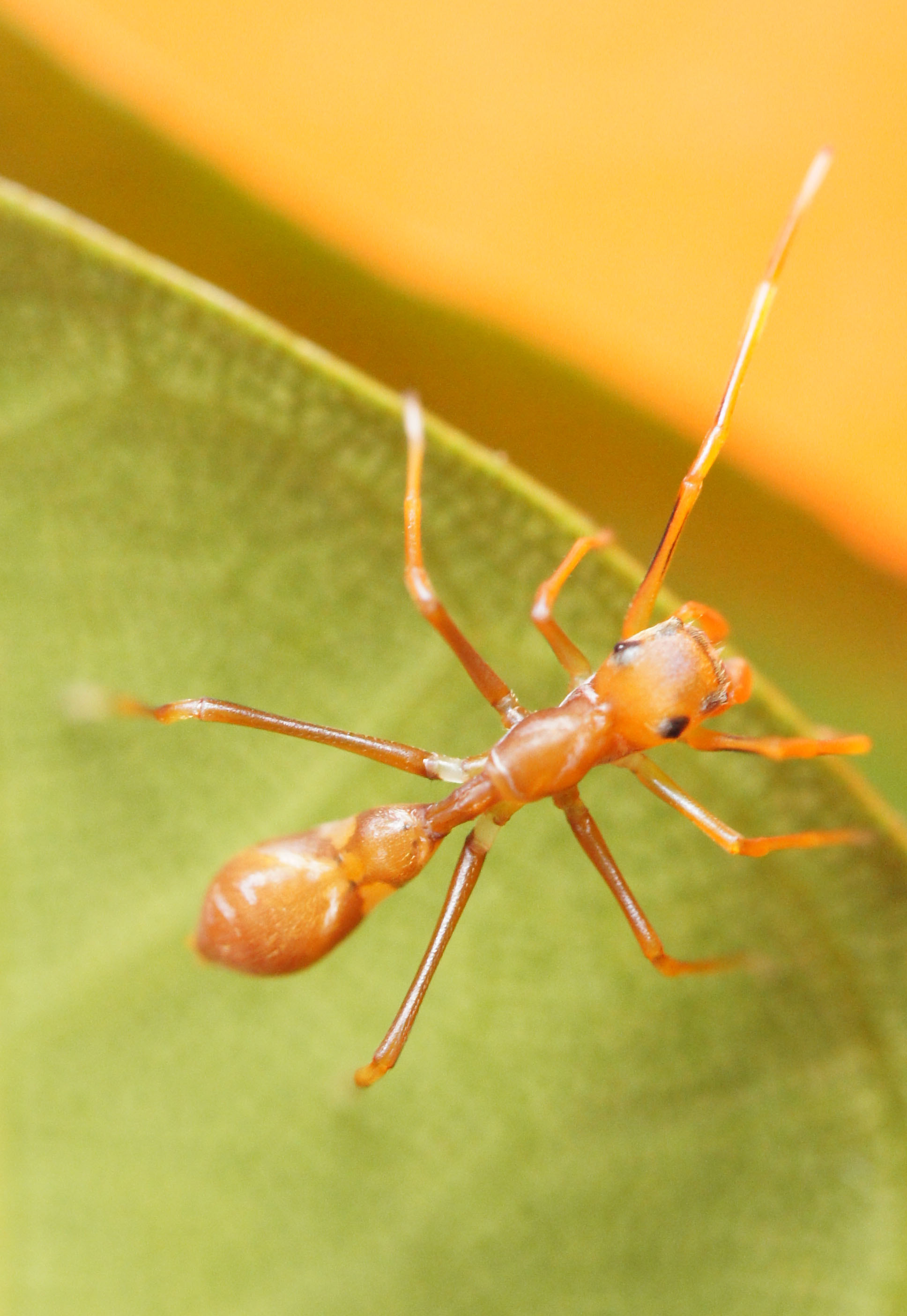 |
| (Photo taken by and with permission from Kai Quan) |
Table of Contents
It’s an ant-mimicking spider! It is commonly known asKerengga ant-like jumper
Impress others by using its scientific name:Myrmarachne plataleoides
Resemblance of a spider to an ant
A typical spider has two segmented body – the abdomen and cephalothorax. For Myrmarachne plataleoides, their abdomens are as long as their cephalothorax. Together with a 'waist', they look like they have a three-segmented body look similar to a typical ant look (Mclver & Stonedahl, 1993). It also has black pigments at the sides of the heads to resemble the larger eyes of the ants (Maderspacher, 2011).To reinforce their mimicry, they wave their first pair of legs in the air while moving so as to portray an “antennal illusion” (Mathew 1954; Edmunds, 1978; Jackson 1986).
Locomotion of Myrmarachne plataleoides:
| (Video taken by Wan Ting) |
Differences between Myrmarachne plataleoides and weaver ants
| Kerengga ant-like jumper |
Weaver Ant |
|||||
| Antenna |
AbsentTheir first pairs of legs come from beneath their cephalothorax to act as antenna
|
PresentFrom the top of their heads
|
||||
| Eyes and location |
2 pairs of eyes at the front of the head 2 pairs of eyes at the side |
1 one pair of eyes at the side |
||||
| 'Mouth' |
Chelicerae/Fangs
|
Mandibles
|
||||
| Abdomen |
Broader abdomen at the posterior (back) end
|
Rounder and shorter gaster
|
||||
| Spinnerets |
Present |
Absent |
||||
| Ability to Jump |
Yes However jumping is usually their last resort escape plan as they do not want to be discovered that they are actually not ants! (Jackson, 1994). |
No |
||||
| Nature |
Fast and gentle Run to the underside of the leaves (Marson, 1946) or jump away and do not bite! |
Aggressive and defensive Open up their jaws in an erected posture |
||||
| Sociality |
Usually solitary
|
Form colonies
|
||||
| Nest |
* Silk produced from individual spinnerets
A very short video on how Myrmarachne plataleoides weaves its nest: (Video taken by Wan Ting) |
* Silk produced from last instar ant larvae (Wilson & Holldobler, 1980)
Weaver ants building their nest together using their larvae. Start watching from 1:15 onwards: Weaver ants weaving their nest together(Video obtained from Youtube under fairuse) |
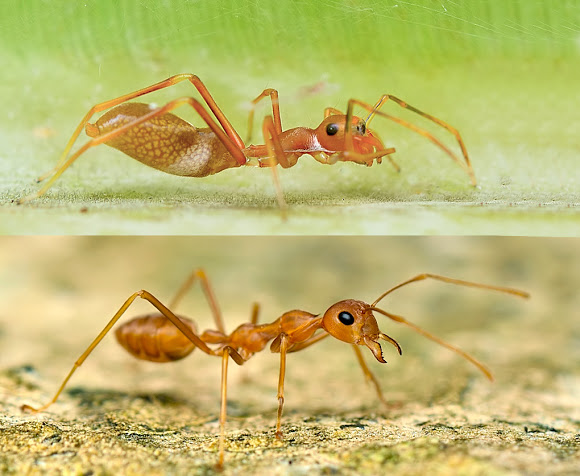 |
| (Photo taken by and with permission from Sunny Joseph) |
Now it is your turn to spot the differences! How many can you spot?
Answer: There are four differences in this picture! Did you spot them all? Click here for the answers!
Purpose of mimicking an ant
Myrmarachne plataleoides are batesian mimics of Weaver ant (Oecophylla smaragdina) which are known to be aggressive, give painful bites and attack together (Holldobler & Wilson 1990). Batesian mimics mean that harmless mimics (Myrmarachne plateleoides) look like their unpalatable models (Weaver ant) (Edmunds 1972, 1993; Cushing 1997). With the combination of both behavioural and morphological mimicry, they deceive potential araneophagic (spider-eating) predators and gain protection (Edmunds 1993; Nelson et al. 2004; Nelson et al. 2005).Although they live close to their hostile ant model – weaver ants and mimic ants, this close association can be life-threatening for them. Hence they will avoid ants upon sighting and keep a safe distance from them. They would either get out of the ant pathway, jump away or simply not get onto the same leaves as the weaver ants. This also means that ants are NOT their food!
These weaver ants are working together to tear down the nest of a Myrmarachne plataleoides.
|
|
Juveniles (young Myrmarachne plataleoides) actually mimic other ant species
Juveniles mimic different ant species at different stages of growth. This is known as transformational mimicry (Mathew, 1934, 1940, 1954; Bhattacharya, 1938; Marson, 1947).What is more fascinating is that:They seem to display different transformational mimicry in different parts of Asia.
- In one part of India, early instars* being dark brown or blackish are found to resemble small black ant Prenolepis (Mathew, 1934) while larger instars resemble Solenopsis
- In another part of India, the first three instars mimic Solenopsis geminata whereas the fourth instars mimic Plagiolepis longipes (Bhattacharya, 1938)
- In Malaysia and Singapore, the late instars (developmental stage between each molt until sexual maturity is reached) appear to mimic small Ocecophylla and the orange ant Anoplolepis which is associated with Oecophylla (Edmunds, 2006).
| An one month old juvenile Myrmarachne plataleoides (about 0.2mm) from Singapore: |
They seem to resemble this ant species: |
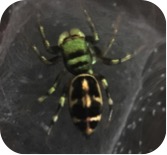 |
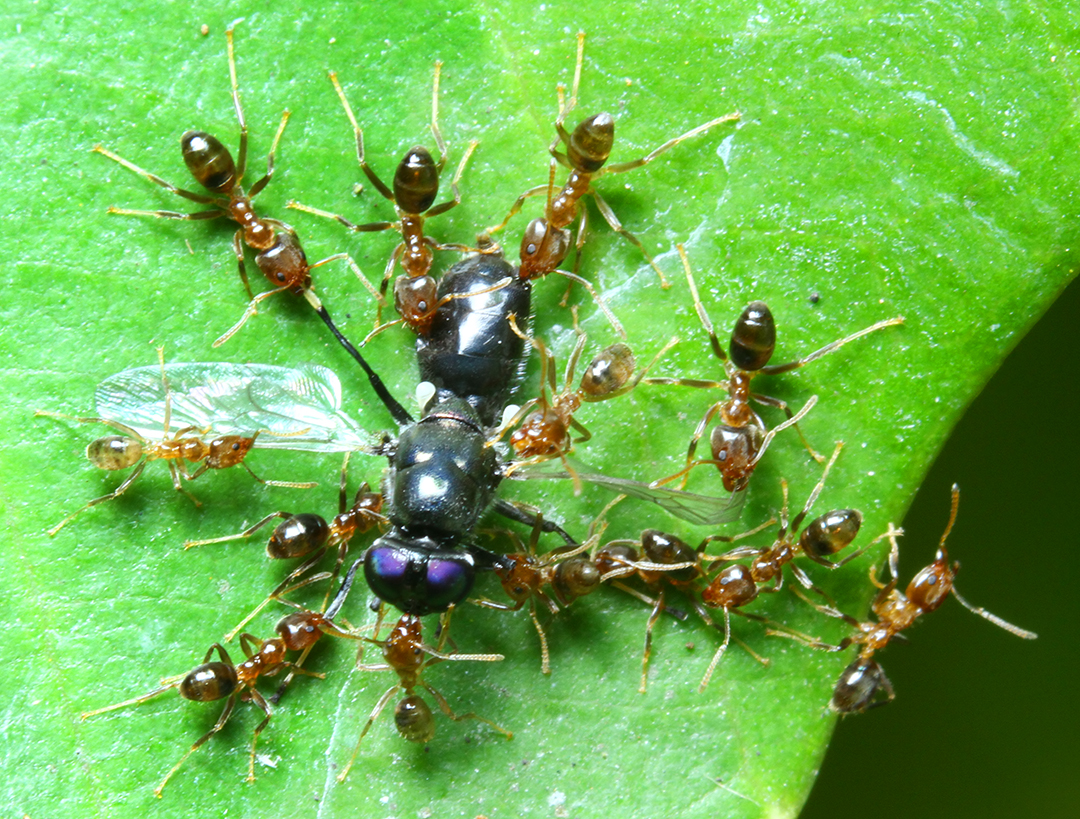 |
| A month old juvenile (0.2mm) of Myrmarachne plataleoides(Photo taken by and with permission from Kai Quan) |
Ant team work (Photo taken by and with permission from Eddy Lee) |
Note: If you have juvenile photos of Myrmarachne plataleoides and would like to contribute to this fascinating fact of juveniles by sharing your photos, please feel free to contact me! You can also contact me if you have even better suggestions of which ant species the juveniles look like.
Moulting
As invertebrates (organisms without backbone), they only have exoskeletons which act like their armours. Every time when they grow larger in size, they have to moult by getting out of their old exoskeletons and new exoskeletons will form just beneath the old ones. It is just like how we have to change new clothes each time we grow bigger in size! During moulting, they are at their most vulnerable states and would stay in their nests throughout the whole progress. Right after they moult, their new exoskeletons would still be soft and time is required before their new exoskeletons harden.Myrmarachne plataleoides struggled out of its exoskeleton. It took about half an hour before it reached the last stage.
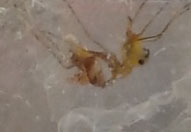 |
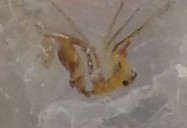 |
 |
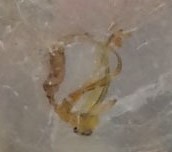 |
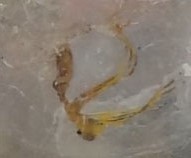 |
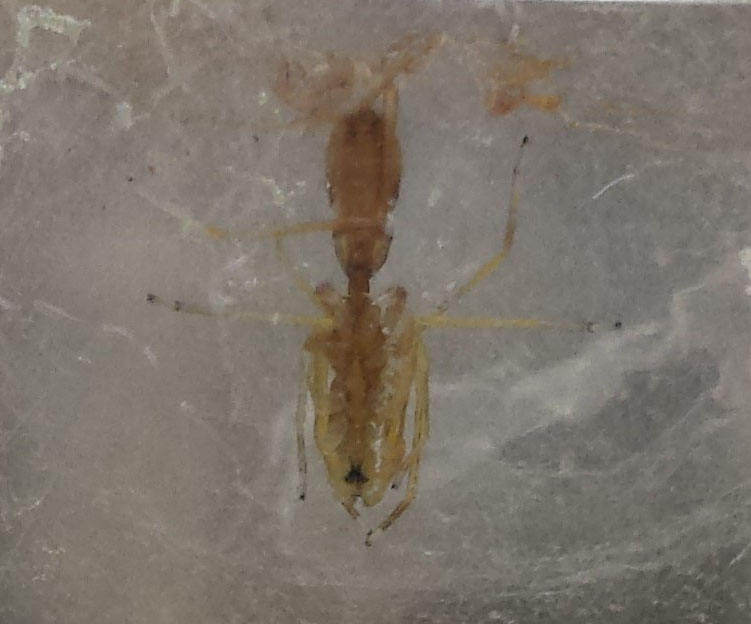 |
Differentiate male and female Myrmarachne plataleoidesTheir sexes could only be determined when they are sexually matured adults.
By cheliceraeChelicerae:Spiders' jaws located in front of the cephalothorax. They are tipped with fangs and muscles to hold their prey in place.
The males have enlarged and elongated chelicerae of about five times longer than those of females. This can increase the male’s length by 50-70% (Pollard, 1994). Due to their elongated chelicerae, they resemble weaver ants less. In addition, the tips of their chelicerae have a black spot which has been suggested that they look like ants’ eyes so the males actually mimic worker weaver ant carrying a dead ant (Mclver & Stonedahl, 1993).
| Weaver ant carrying another ant |
Male Myrmarachne plataleoides |
Female Myrmarachne plataleoides |
||||||
|
|
|
By their genitals
For males, look at: Pedipalps of the males under the microscope.
For females, look at: Epigyne (on the underside of female’s abdomen)
| Pedipalps of male Myrmarachne plataleoides |
Epigyne of female Myrmarachne plataleoides |
||||
|
|
Other Myrmarachne species
In the family Salticidae (Jumping spiders), Myrmarachne is one of the largest genera with currently 217 species described (Platnick, 2013). You can identify different Myrmarachne species by looking at their epigyne or pedipalps too. Different male Myrmarachne species differ in their chelicerae shape as well hence sometimes this feature help us to tell them apart using our naked eyes.
Some examples of Myrmarachne species found in Singapore. For Myrmarachne plataleoides, it is easier to identify them due to their colour and their close association with weaver ants.
| Scientific name |
Sex |
Pedipalps of males/ Epigyne of females |
|||||
| Myrmarachne cornuta |
Male |
|
|
||||
| Female |
|
|
|||||
| Myrmarachne maxillosa |
Male |
|
|
||||
| Female |
|
Not available |
Reproduction
Mating behavior
Cohabitation of female and male
Males will build a translucent nest beside the densely woven and completely opaque nest of a sub-adult (one more moult to become sexually matured) female. After the female moults to become sexually matured, the male will enter her nest to mate with her. Females are more willing to mate at the nests rather than away (Jackson, 1982).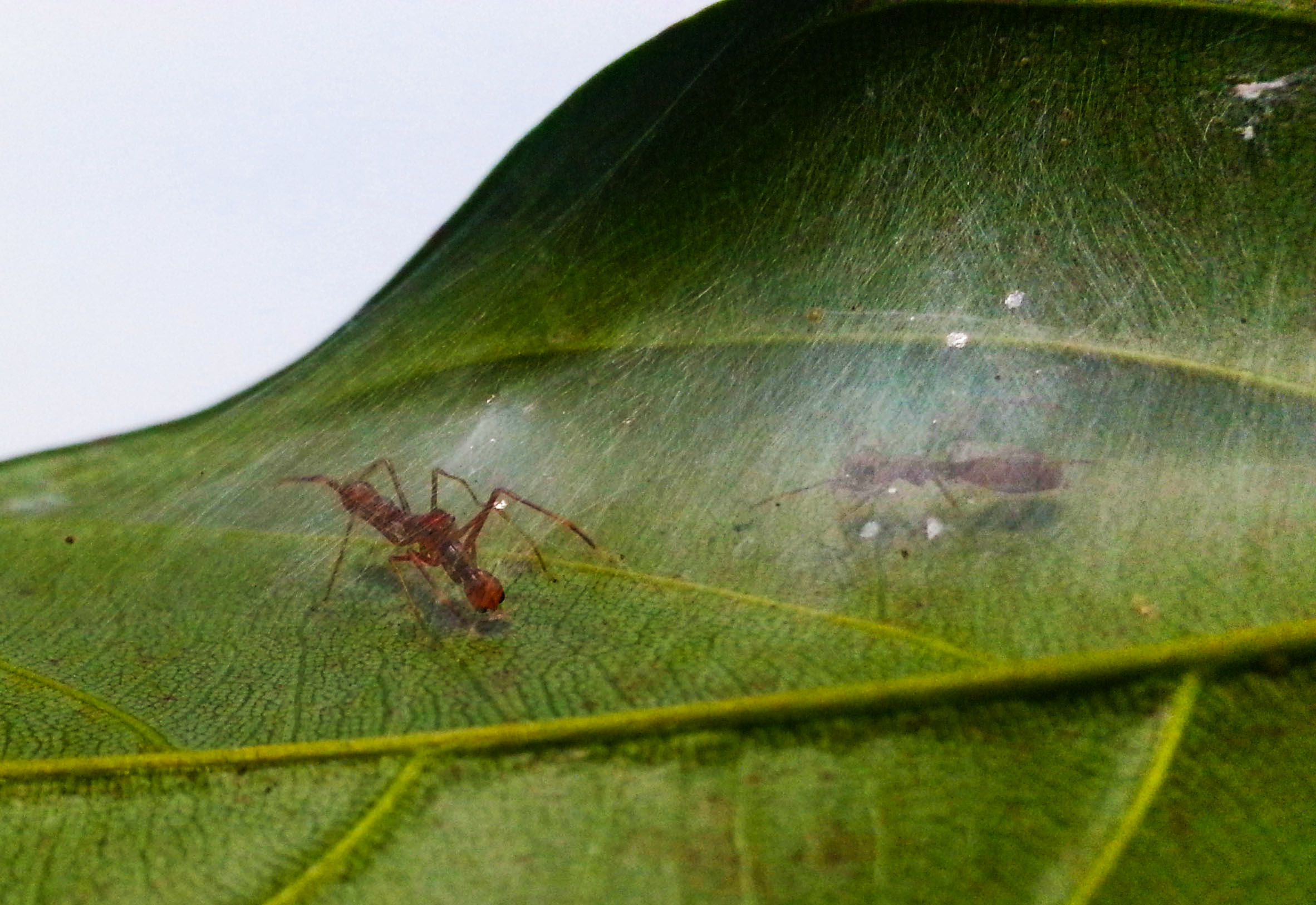 |
| Male kerengga ant-like jumper (on the left) cohabiting with female (on the right). (Photo taken by Wan Ting) |
Courtship away from the nest
The males will arch their palps and lower their bodies, twitching their abdomens when they face the females. Then they will continue posturing either stationary or walking. They will chase or block the females if they run away. Sometimes they will even do a zigzag dance to mesmerize the females.Watch how the male jumping spider charms the female jumping spider to mate with him. It is more than just visual display!
This is the funnier version:
| Video of the male jumping spider charming the female jumping spider with his courtship display.(Video obtained from Youtube under fairuse) |
This version explains what the male jumping spider is doing exactly during his zigzag dance which we cannot see with our naked eyes. Hence watch to understand the mechanism behind the display from PBS.org at:
http://www.pbs.org/wnet/nature/video/what-males-will-do-video-spider-courtship-dance/956/
Mating
Mating occurs when the palps of the male applies to the epigyne of the female. When this happens, the male is always beside the female and orientated 180 degree to each other. Sometimes, the male will alternate different sides of his palps by freeing from her and moving to the other side of her. The females will remain stationary when the males apply their palps (Jackson, 1982).Male-male competition
Unlike other jumping spiders which fight using their first pair of legs, male Myrmarachne plataleoides are able to fight with each other using their enlarged chelicerae.Two male ant-mimic spiders wrestling! They can be really fierce.
| Video of two ant-mimic spiders wrestling.(Video obtained from Youtube under fairuse) |
Parental care
The female will weave dense opaque nest over her nest first followed by another layer over herself. She will lay about 18 eggs which can be yellow or orange in colour. She will then continue to stay in the nest until the eggs hatch into spiderlings and come out occasionally to hunt. Upon hatching, the spiderlings will to continue to stay in the nest for a week or so to develop until they are ready to leave! As they are really tiny, they will feed on nectar and they can actually weave really tiny nest over themselves too!Do you know?
Some females can lay eggs for the second time after her 'old' eggs have hatched into spiderlings.
 |
| Female kerengga ant-like jumper in her nest and her eggs beneath her (Photo taken by Wan Ting) |
Distribution
Habitats
They can be found on shrubs or tree trunks (example: Jackfruit trees or Palm trees) at the forest edges or at the parks. Usually when you see weaver ants, you can try to look out for them too.Countries
They are widely distributed in India, Sri Lanka, Kerala, China, Singapore, Malaysia, Thailand and Southeast Asia (Hill, 2010).In Singapore
Note: If you know of any other places which Myrmarachne plataleoides, please feel free to let me know and show me a picture of it if possible.
Ecology
Diet
They are generalist predators of insects but do not prey on ants (Jackson & Pollard, 1996). They hunt for their food (example: flies and grasshoppers) in the day and they sleep at night. Hence they are known as diurnal hunters (Jackson & Pollard, 1996). Their diets contain spiders as well and they will even eat their own kinds.Prey capture
Due to the modified chelicerae in male Myrmarachne plataleoides, their fang ducts have been lost and they cannot immobilize prey with venom. Furthermore, they cannot insert fangs into prey as soon as they land on them. As a result, large and moving prey can escape from males more easily than females (Jackson, 1986).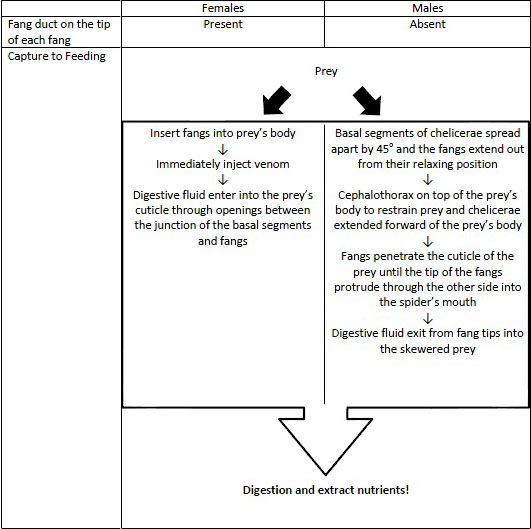
How the male Myrmarachne plataleoides skewered its prey:
|
|
Male Myrmarachne plataleoides attacking a dead male Myrmarachne plataleoides at 0.25x the actual speed. (Actual speed is less than a second):
| Video of male Myrrmarachne plataleoides attacking a dead male Myrrmarachne plataleoides(Video taken by and with permission from Kai Quan) |
Predators
They get eaten by araneophagic (spider-eating) predators such as ants, mantises and even salticids (Nelson et al., 2006).Do you know?
Unfortunately, sometimes their mimicry also managed to fool mymecophagic (ant-eating) spiders that they are ants. Hence these mymecophagic salticids which mistaken them as ants would eat them too. However, if they manage to fully extend their forelegs 45 degrees to the side and elevate their legs at 45 degrees (also known as the erect-legs posture (Jackson, 1982)) to show ant-eating spiders that they are not ants in time, they can escape (Nelson et al., 2006).
Example of a mymecophagic (ant-eating) spider. This is also known as the ant-mimic crab spider:
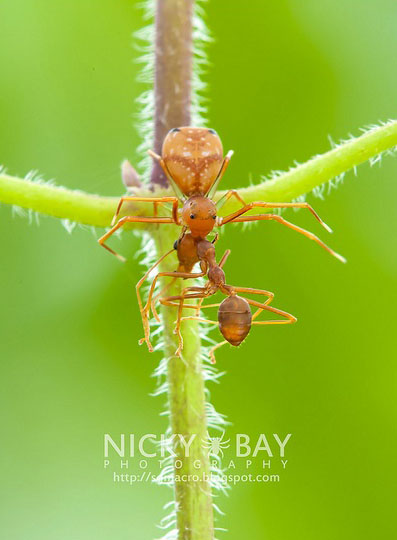 |
| (Photo taken by Nicky Bay. Permission pending) |
Taxonomy
Myrmarachne plataleoides (Pickard-Cambridge O., 1869) is an accepted name. (Catalogue of life)Extra knowledge: The meaning of parentheses in the scientific names
1. In 1869, Pickard-Cambridge who first discovered and described Myrmarachne plataleoides as Salticus plataleoides
2. After some time, it was discovered that it actually belongs to the genus group - Myrmarachne
3. According to Nomenclature rules (ICZN), the first author who described it has his name enclosed in parentheses to show that the species has transferred generic group.
Taxonavigation
| Kingdom |
Animalia |
| Phylum |
Arthropoda |
| Class |
Arachnida |
| Order |
Araneae |
| Suborder |
Araneomorphae |
| Family |
Salticidae |
| Subfamily |
Myrmarachninae |
| Genus |
Myrmarachne |
| Species |
Myrmarachne plataleoides |
The table refers to taxonomic ranks for biological classification. Down the column, organisms are grouped together based on increasing similarities (within themselves) and differences from other groups of organisms (based on DNA sequences, morphology and more). However, these groups are not fixed/subjective and the organism can be transferred from one group to another group within the same rank (for example, genus Salticus to Myrmarachne) when taxonomic revision is done. These ranks provide a quick and rough idea on what kind of characteristics an organism has.
Phylum ArthropodaExtra knowledge by watching the video to have better understanding of arthropoda:
| (Video obtained from Youtube under Fairuse) |
Brief notes from the video:
Phylum Arthropoda
- They have exoskeleton made of chitin
- They are bilateral symmetrical
- They have open circulatory system
Class Arachnida
- They have 2 body segments - Cephalothorax and abdomen (opisthosoma)
- They have 8 legs
- Spiders breathe using book lungs filled with haemolymph (arthropod blood)
Family Salticidae (Jumping spiders)
- Active, diurnal predators (Hunt in the day and sleep at night)
- Ability to jump while leaving behind a dragline
- Hunt using their acute vision by having unique complex eyes
Eyes
- 4 pairs of eyes
- The largest pair of eyes is known as the principal eyes
- Help them focus and pursuit their prey accurately (Jackson & Tarsitano, 1993).
- Identify mates, predators and rivals (Forster, 1979 & 1982; Nelson& Jackson, 2006a).
A documentary about the different groups of spiders on Earth. Start at 26:30 to learn more about Jumping spiders.
| Documentary of spiders from National Geographic(Video obtained from Youtube under Educational use of content) |
Interesting response of Jumping spiders' eyes to green/red light:
| (Video obtained from National geographic under Educational use of content) |
Meaning of Myrmarachne
In Ancient Greek 'myrmex' means ant and 'arachne' means spider. From Myrmarachne plataleoides's mimicry, you can tell why it is in this genus.Myrmarachne species are known to associate with a dominant ant species in their habitat and/or an aggressive ant species with a potent sting. This means that they are generally species-specific - one particular Myrmarachne species mimic one particular ant species. Although it has also been noted before that some species may be generalized ant mimics (which means some Myrmarachne species resemble a few ant species), this may be due to the lack of studies of those species (Edwards & Benjamin, 2009).
Extra knowledege: Review of MyrmarachneMyrmarachne species have variable and unique development of the spermathecae and attached ducts which may be exclusive to them only in the Salticidae family. All the species have a basic distinctive epigyne shape with a sclerotized, elongate spermathecal complex (consisting of the anteriorly placed spermathecae with sclerotized ducts extending posteriorly) connected by membranous ducts to the copulatory openings. Although the male palps can be used as a diagnostic feature, they are not as distinctive as the spermathecal complex of female epigyne..
Unfortunately, Myrmarachne genus is poorly supported in the phylogenetic analysis and species group cannot be determined accurately. This may be due to:
- Lack of illustrations of diagnostic membranous internal structure and other structural details of epigyne for several described species.
- New Myrmarachne species are still being discovered recently (Yamasaki & Edwards, 2013)
- 2 genera (Bocus (from Borneo and the Philippines) and Panachraesta (from India)) are incompletely diagnosed
Bocus may actually be a different genus that has a possible recipient of species of Myrmarachne and is part of the phylogenetic analysis of the Myrmarachne in the following phylogenetic tree. Hence by synonymizing Bocus with Myrmarachne, Myrmarachne will become a bigger genus than it should be (Edwards, 2013).
Note:Spermathecal complex = epigyne = sexual organ in the females for male pedipalp to enter (shown in the pictures above and below).
Phylogenetic tree
Extra knowledge: Phylogenetic tree is a branching diagram which shows the evolutionary relationships between the species based on similarities or differences in their characters (genetic, morphology etc).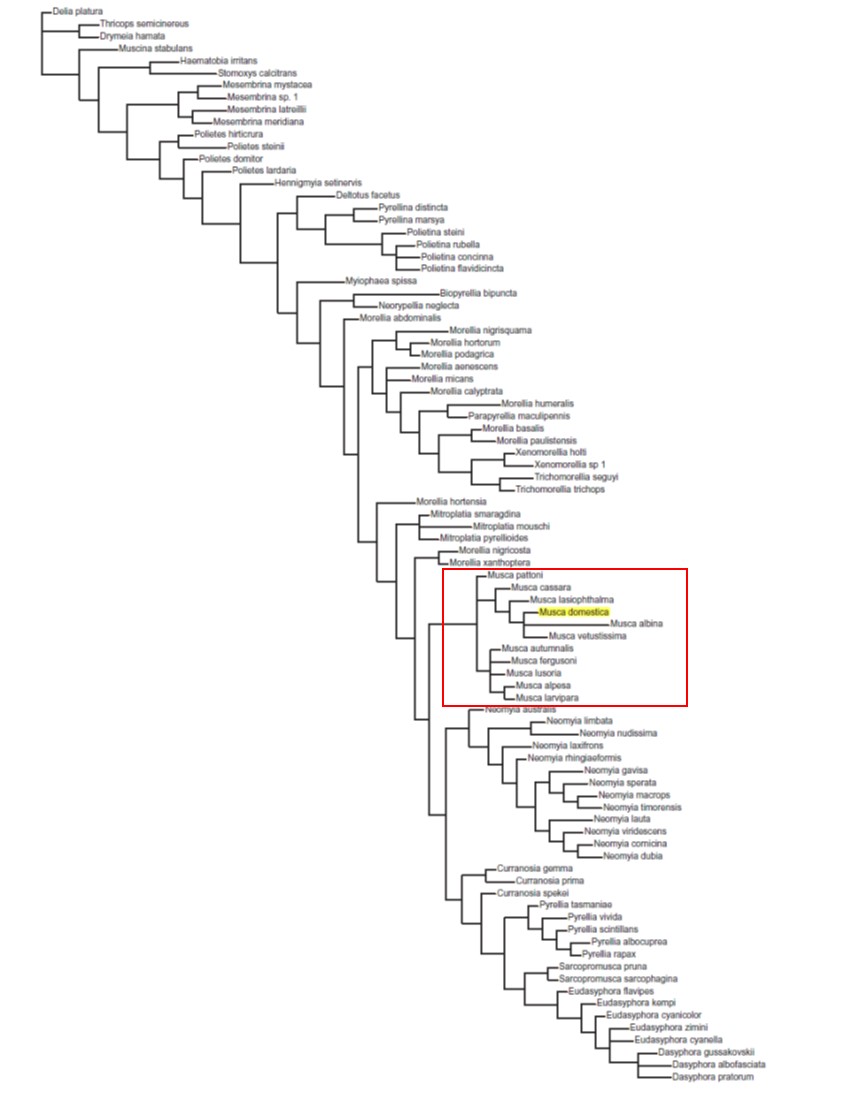
From the phylogenetic tree, there are 10 species groups of Myrmarachne (electrica, formicaria, grossa, laurentina, lesserti, nubilis, parallela, plataleoides, tristis, volatilis) with the formicaria and tristis groups having the most species.
These 10 groups are assigned to 3 main clades of Myrmarachne, tentatively called:
- 'Australasian clade' (southern Asia to Australia)
- 'Trans-Indian Ocean clade' (Madagascar and Borneo)
- 'Western clade' (mainland Africa with outliers in Eurasia, and the Neotropics)
The last two clades are sister groups.
Myrmarachne plataleoides is always paired with Bocus excelsus in the phylogenetic tree means that both of these species are very likely to evolve from the same most recent common ancestor.
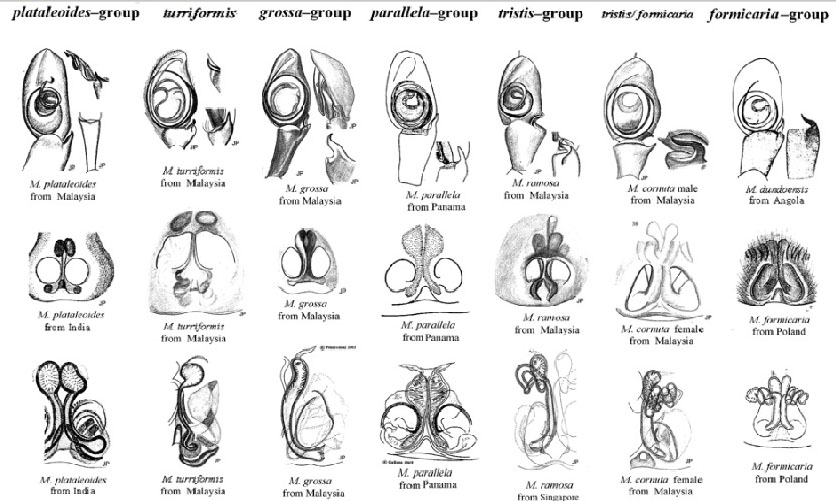
"Plataleoides group is in the 'Australasian clade' and are diagnosed in females by a very narrow spermathecal complex terminating in front of the atria and small oval spermathecae. In male Myrmarachne plataleoides, the initial coil of the embolus is distinctively shorter and broad in the proximal half of the bulbus, with an even shorter elevated terminal coil, which gives the embolus a cork-screw appearance. The embolus tip is recurved and truncate, unique to this species." adapted from Edwards & Benjamin, 2009.
Synonymised taxa
Myrmarachne daitarensis Prószynski, 1992 (synonym)Myrmarachne plataleoides Simon, 1901 (synonym)
Salticus plataleoides Pickard-Cambridge O., 1869 (synonym)
Extra knowledge: What is a synonym?
Only one correct scientific name is accepted at any one time in taxonomy. However, sometimes, the same taxon is named more than once independently or there is a change in the existing taxa (for instance, two genera are merged to become one) (ICZN). This results in synonyms (inappropriate scientific name of the same species). This means that when you search for data and you come across Myrmarachne daitarensis (for example), it means that the species is actually referring to Myrmarachne plataleoides.
Locations of some specimens
1) In Termezettudomanyi Muzeum Allatara, Budapest, Baross utca 13, Budapest VIII, Hungary
2) Museum of Comparative Zoology, Harvard University, Cambridge, USA.
3) Zoologisk Museum, Kobenhavn, Universitetsparken 15, Denmark.
4) British Museum (N.H), London, Cromwell Road, London S.W.7., Great Britain
5) Museum National d’Histoire Naturelle, Paris, 61, rue de Buffon, Paris V. France.
6) Zoologische Abtoilung, Naturhistorisches Museum, Wien, A-1014 Wien I, Burgring 7. Austria.
7) The Florida Arthropod Collection, FDACS, Division of Plant Industry, Gainesville. P.O.Box 147100, 1911 SW 34th St., Gainesville, FL 32614-7100, Gainesville, USA.
8) Institut für Systematische Zoologie, Museum für Naturkunde der Humboldt-Universität, Berlin. Germany. Part of older collections preserved as dry, type specimens marked by asterisk
Note: The location of the holotype is unknown.
Extra knowledge: Meaning of holotype
A single physical specimen of an organism used to formally describe and name the species.
I would like to show my appreciation to:
Albert TamayoDaniel RuyleEddy LeeKai QuanNicky BaySckelShekainah d. alabanSunny Joseph
Without their photos, this webpage will be very plain and understanding of Myrmarachne plataleoides will be less comprehensive. In addition, you can click on their names to view more of their photos.
I hope that this webpage gives you an introduction to the fascinating world of Ant-mimic spiders and allow you to view weaver ants with a different light next time since you know that Myrmarachne plataleoides may be among them. You can start spotting them!
Useful Resources
Spiders
Dedicated to MyrmarachneAll the different species names in Myrmarachne: http://tolweb.org/Myrmarachne/3120
All the diagnostic drawings of pedipalps and epigyne of Myrmarachne species in the world: http://salticidae.org/salticid/diagnost/myrmar/myrmar.htm
Useful journal to know what characters are used to analyse phylogeny for Myrmarachne: Edwards, G.B. & Benjamin, S.P., 2009. A first look at the phylogeny of the Myrmarachninae, with rediscovery and redescription of the type species of Myrmarachne (Araneae:Salticidae). Zootaxa 2309: 1-29
Spiders in general
Useful information about Jumping spiders: http://www.jumping-spiders.com/
Another website about Jumping spiders: http://www.peckhamia.com/salticidae/
More about spiders anatomy: http://www.mnh.si.edu/highlight/sem/spiders.html
More about spiders: http://science.howstuffworks.com/zoology/insects-arachnids/spider.htm
Easy to understand information about spiders: http://www.biology4kids.com/files/invert_main.html
Simple spider anatomy: http://www.uky.edu/Ag/CritterFiles/casefile/spiders/anatomy/spideranatomy.htm
Taxonomy & other information
Information about nomenclature (naming of species): http://iczn.org/content/about-icznMovable interesting phylogenetic tree: http://www.brown.edu/Faculty/Dunn_Lab/phylotree
The conservation status of organisms: http://www.iucnredlist.org/
Glossary of the taxonomic terms: http://bio.slu.edu/mayden/systematics/glossary.html
Photos
A great website to view nature photos: http://www.projectnoah.org/
Excellent macro shots by Nicky bay to learn about mostly inverterbrates: http://sgmacro.blogspot.com/
References
Journals and books- Bhattacharya, G.C., 1938. On the moulting and metamorphosis of Myrmarachne plataleoides, Camb. Transactions of the Bose Institute, Calcutta 12: 103-114.
- Cushing, P.E., 1997. Myrmecomorphy and myrmecophily in spiders:a review. Florida Entomological Society 80: 165-93.
- Edmunds, M.E., 1972. Defensive behavior in Ghanaian preying mantids. Zoology Journal of Linnean Society 51: 1-32.
- Edmunds, M., 1978. On the association between Myrmarachne spp. (Salticidae) and ants. Bulletin of the British Arachnological Society 4: 149-160.
- Edmunds, M., 2006. Do Malaysian Myrmarachne associate with particular species of ant? Biological Journal of the Linnean Society 88: 645-653
- Edmunds, M., 1993. Does mimicry of ants reduce predation by wasps on salticid spiders? Memoirs of the Queensland Museum 33: 507-512.
- Edmunds M,. & Proszynski J., 2003. On a collection of Myrmarachne spiders (Araneae: Salticidae) from peninsula Malaya. Bulletin of the British Arachnological Society 12: 304-306
- Edwards, G.B. & Benjamin, S.P., 2009. A first look at the phylogeny of the Myrmarachninae, with rediscovery and redescription of the type species of Myrmarachne (Araneae:Salticidae). Zootaxa 2309: 1-29
- Forster, L.M., 1979. Visual mechanisms of hunting behaviour in Trite planiceps, a jumping spider (Araneae: Salticidae).
- Forster, L.M., 1982. Vision and prey- catching strategies in jumping spiders. Am. Sei. IO: 165-75
- Hill, D.E., 2010. Sunda to Sahul: Trans-Wallacean distribution of recent salticid genera (Araneae: Salticidae). Peckhamia 80: 1-60
- Holldobler, B. & Wilson, E.O., 1990. The ants. Heidelberg, Germany: Springer-Verlag.
- Jackson, R.R., 1982. The biology of ant-like jumping spiders: Intraspecific interactions of Mymarachne lupata (Araneae: Salticidae). Zoological Journal of the Linnean Society 76: 293-319.
- Jackson, R.R., 1986. The biology of ant-like jumping spiders (Araneae:Salticidae): prey and predatory behaviour of Myrmarachne with particular attention to M.lupata from Queensland. Zoological Journal of the Linnean Society 88: 179-190.
- Jackson, R.R., 1994. The comparative study of the predatory behaviour of Myrmarachne, ant-like jumping spiders (Araneae: Salticidae). Zoological Journal of the Linnean Society 110: 77-102.
- Jackson, R. R. & Pollard, S. D., 1996. Predatory behavior of jumping spiders. Annual Review of Entomology. 41: 287-308
- Jackson, R.R. & Tarsitano, M.S., 1993. Responses of jumping spiders to motionless prey. Bulletin of the British Arachnological Society. 9: 105-9
- Marson, J.E., 1947. The ant mimic Myrmarachne plataleoides. Journal of the East African Natural History Society 19: 62- 63.
- Mathew, A.P., 1934. The life-history of the spider (Myrmarachne plataleoides) (Cambr). Journal of the Bombay Natural History Society 37: 369-374.
- Mathew, A.P., 1940. A study of the courting habits of Myrmarachne plataleoides (Cambr.) − a spider mimic of the Indian red-ant Oecophylla smaragdina. Journal of the Bombay Natural History Society 42: 171-180.
- Mathew, A.P., 1954. Observations on the habits of two spider mimics of the red ant, Oecophylla smaragdina (Fabr.). Journal of the Bombay Natural History Society 52: 249-263.
- Maderspacher, F., 2011. Myrmecomorphomania. Current Biology 21: R291-R293.
- Mclver, J.D. & Stonedahl, G., 1993. Myrmecomorphy: morphological and behavioural mimicry of ants. Annual Review of Entomology 38: 351-379.
- Nelson, X.J., Jackson, R.R, Pollard, S.D, Edwards, G.B & Barrion, A.T., 2004. Predation by ants on jumping spiders (Araneae : Salticidae) in the Philippines. New Zealand Journal of Zoology 31: 45-56.
- Nelson, X.J., Jackson, R.R, Pollard, S.D, Edwards, G.B & Barrion, A.T., 2005. Living with the enemy: jumping spiders that mimic weaver ants. Journal of Arachnology 33: 813-819.
- Nelson, X.J., Jackson, R.R. & Li, D., 2006. Conditional use of honest signaling by a Batesian mimic. Behavioral Ecology 17: 575-580.
- Nelson, X. J. & Jackson, R. R., 2006a. Vision-based innate aversion to ants and ant mimics. Behavioral Ecology 17: 676-681
- Nelson, X.J., Jackson, R.R., Li, D., Barrion, A.T. & Edwards, G.B., 2006. Innate aversion to ants (Hymenoptera: Formicidae) and ant mimics: experimental findings from mantises (Mantodea), Biological Journal of the Linnean Society 88: 23–32
- Peckham G.W. & Peckham E.G., 1892. Ant-like Spiders of the Family Attidae. Occasional papers of Natural History of Society of Wisconsin 2: 32
- Pollard, S.D., 1994. Consequences of sexual selection on feeding in male jumping spiders (Araneae: Salticidae). The Zoological Society of London 234 :203-208
- Simon, E., 1901a. Histoire Naturelle des Araignees. 2(3-4) Paris: 499, 590-592
- Trager, J.C., 1991. A Revision of the Fire Ants, Solenopsis geminata Group (Hymenoptera: Formicidae: Myrmicinae). Journal of the New York Entomological Society 99: 141-198.
- Wilson, E.O. & Holldobler, B., 1980. Sex differences in cooperative silk-spinning by weaver ant larvae. National Academy of Sciences of the United States of America 77: 2343-2347.
- Yamasaki, T. & Edwards, G.B., 2013. The genus Myrmarachne (Araneae, Salticidae) in Flores, Indonesia. ZooKeys 299: 1-20
Online references
- Catalogue of Life, 2013. Synonyms of Myrmarachne plataleoides [Online]. Available from http://www.catalogueoflife.org/col/details/species/id/7892127 [Accessed 10 November 2013]
- International Commission on Zoological nomenclature. [Online] http://iczn.org/content/about-iczn [Accessed 22 November 2013]
- Metzner, H., 2013. Worldwide distribution of Myrmarachne. Worldwide database of jumping spiders (Arachnida, Araneae, Salticidae) [Online] Available from http://www.jumping-spiders.com/ [Accessed 22 November 2013].
- Smithsonian Institution, 2013. Anatomy of spiders. [Online] Available from http://www.mnh.si.edu/highlight/sem/spiders.html [Accessed 22 November 2013]
- The IUCN Red List of threatened species, 2013. Conservation status of Myrmarachne plataleoides. [Online] Available from http://www.iucnredlist.org/search [Accessed 10 November 2013]
- Platnick, N. I., 2013. The world spider catalog, version 14.0. American Museum of Natural History [Online] at http:research.amnh.org/entomology/spiders/catalog/index.html.
- Prószyński, J., 2012. Diagnostic drawings of epigyne and pedipalps [Online] Accessed from http://www.peckhamia.com/salticidae/salticidae.php?adres=specimen.php?id=2721 [Accessed 22 November 2013]
Author of this webpage:
- Sim Wan Ting (Contact me by clicking my name)
